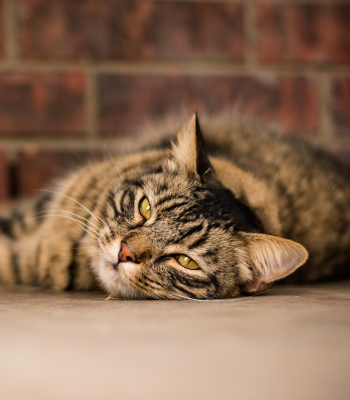Feline Infectious Peritonitis (FIP) in Cats: Treatment, Palliative Care options, and How to know when it’s time for euthanasia
Feline Infectious Peritonitis (FIP) is a devastating disease caused by a mutation of the feline coronavirus. While most cats infected with feline coronavirus experience only mild gastrointestinal symptoms, in some cases, the virus mutates into a deadly form that leads to FIP. This disease is most common in young cats, particularly those from multi-cat environments such as shelters or breeding facilities.
FIP presents in two primary forms: wet (effusive) FIP and dry (non-effusive) FIP. The wet form is characterized by the accumulation of fluid in the abdomen or chest, leading to breathing difficulties and a swollen belly. The dry form typically affects organs such as the liver, kidneys, and brain, causing neurological symptoms, weight loss, and lethargy. Both forms are progressive and, without treatment, are almost always fatal.
Treatment Options for FIP
Until recently, FIP was considered untreatable, but new antiviral treatments have changed the outlook for some cats. The main options include:
1. GS-441524 Treatment
- Pros: This antiviral drug has shown promising results, with many cats achieving full remission. It can halt the progression of FIP and, in some cases, completely cure the disease.
- Cons: The treatment is expensive and not yet FDA-approved, making it difficult to access in some regions. It requires strict adherence to a treatment protocol, including daily injections or oral medication for 84 days.
2. Steroid and Supportive Therapy
- Pros: If GS-441524 is not an option, steroids such as prednisolone can provide temporary symptom relief by reducing inflammation.
- Cons: This does not treat the underlying disease, and the benefits are short-lived. Eventually, symptoms will worsen.
3. Experimental Treatments (Molnupiravir, Other Antivirals)
- Pros: Ongoing research is uncovering new potential treatments, and some have shown promise in early trials.
- Cons: These options are not widely available, and their long-term efficacy remains uncertain.
Palliative Care for Cats with FIP
If curative treatment is not an option, palliative care focuses on maintaining the best possible quality of life for as long as possible. The goal is to manage symptoms and ensure the cat is comfortable and free from suffering.
1. Managing Fluid Buildup (Wet FIP)
- What Helps: Draining fluid from the abdomen or chest can temporarily relieve discomfort and breathing difficulties.
- Challenges: Fluid will continue to accumulate, sometimes rapidly, requiring repeated procedures.
2. Pain and Inflammation Control
- What Helps: Steroids (prednisolone) and non-steroidal anti-inflammatory drugs (NSAIDs) can help reduce pain and inflammation.
- Challenges: These medications provide only temporary relief and may have side effects over time. Steroids and NSAIDs should not be used together.
3. Appetite Stimulation, nausea medications, and Nutritional Support
- What Helps: Appetite stimulants such as Mirataz (mirtazapine) can help stimulate your cat’s appetite. Cerenia (maropitant) is a nausea medication that can help with nausea associated with FIP.
- Challenges: Many cats with FIP lose interest in food as the disease progresses, making feeding difficult.
4. Hydration Support
- What Helps: Subcutaneous fluids can prevent dehydration and improve overall well-being.
- Challenges: Some cats find fluid administration stressful.
5. Comfort Measures
- Provide a warm, quiet space with soft bedding.
- Minimize stress by keeping their environment calm.
- Offer gentle companionship without forcing interaction.
How to Know When It’s Time for Euthanasia
If you have a cat with FIP, you may find yourself facing the difficult decision of when it’s time for euthanasia.
First, I recommend taking our quality of life quiz to help you assess your cat’s quality of life. The quiz can be taken once to give you a snapshot or multiple times to assess trends.
I also recommend keeping a daily journal of your cat’s quality of life in a journal. I recommend simply putting a smile for a good day and a frown for a bad day. The journal can also be a place where you write new memories you made with your cat each day. It is important when facing the end of life to live in the moment and cherish every single day.
Finally, the most compassionate choice is to give your cat a peaceful goodbye before too much suffering has set in. If you do this, you can give your cat the gift of a peaceful last day, and they don’t need to know the severe suffering that often accompanies end-stage FIP. When you are starting to see more bad days than good days, it’s a good time to give them a beautiful send-off.
When clients wait too long, they often end up having to rush their kitty to the emergency room for euthanasia, which is scary and traumatic for both cats and pet parents.
Signs It May Be Time to Consider Euthanasia
- Severe Weight Loss & Muscle Wasting: If your cat is losing significant weight despite attempts to feed them, their body may no longer be absorbing nutrients properly.
- Uncontrollable Pain or Discomfort: If pain medications are no longer effective and your cat shows signs of persistent distress, euthanasia may be the kindest option.
- Difficulty Breathing: Labored breathing, open-mouth breathing, or gasping indicate severe distress and should not be allowed to continue.
- Persistent Vomiting or Diarrhea: If gastrointestinal symptoms become unmanageable despite medication, your cat’s quality of life is severely diminished.
- Complete Loss of Interest in Life: If your cat no longer engages with their favorite activities, seeks affection, or responds to your presence, they may be withdrawing due to discomfort.
Final thoughts
If you are not sure what to do and would like more guidance and support, we offer comprehensive teleconsults with compassionate veterinarians. We will review all your pet’s medical records and history, discuss all your options, and help you formulate the most compassionate and loving plan for your family.
And when it does come time, Paws at Peace offers in-home euthanasia to help your cat pass peacefully at home, surrounded by family. Home euthanasia can provide your cat with a gentle and dignified transition without the stress of a veterinary visit.

